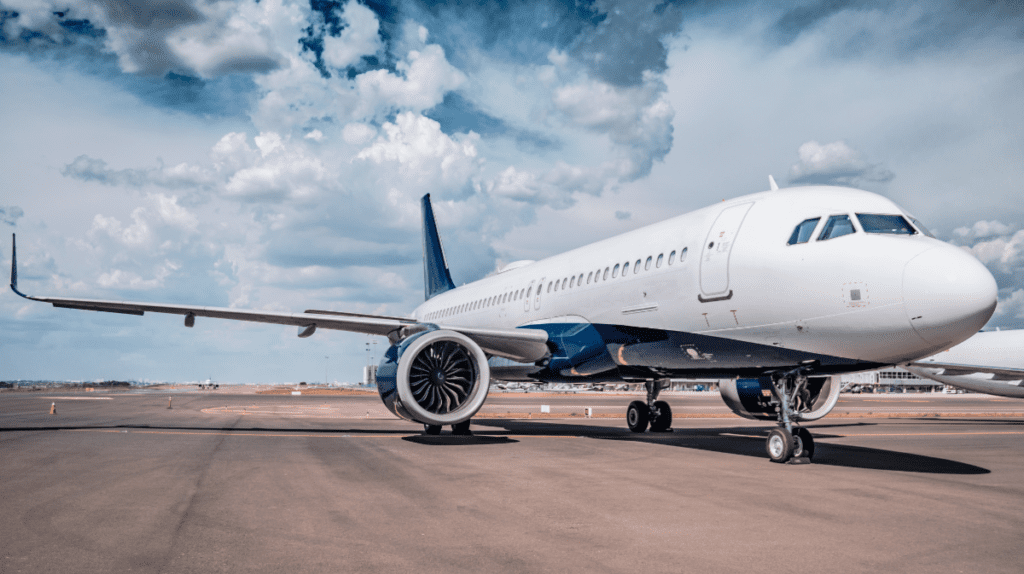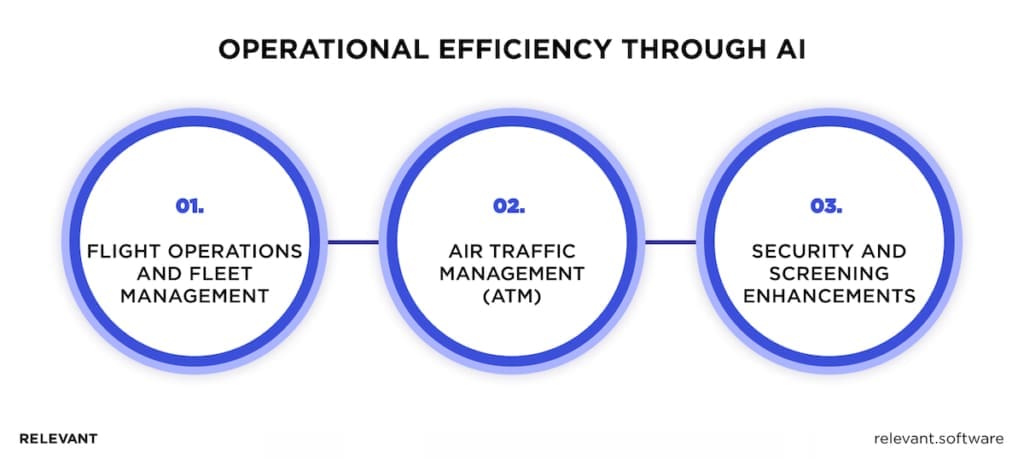AI in Aviation Industry: A Synergy Aimed at Innovation
Updated: July 30, 2024
In a world where the speed of innovation surpasses even the ambitions of its pioneers, artificial intelligence (AI) has become the driving force for change. This very dynamic has fueled the rise of AI in aviation industry – no matter how conservative it may be.
This means that AI-centric tools, including machine learning, natural language processing, and computer vision, are incrementally being introduced into nearly all segments of modern aviation. This trend is more than speculation; data indicates that the global market for AI in aviation is poised to soar to $9,985.86 million by 2030.

We provide companies with senior tech talent and product development expertise to build world-class software. Let's talk about how we can help you.
Contact usNo longer merely an option, AI in aviation has transitioned into an essential component. Thus, let’s examine more closely all the advantages of AI development services for aviation needs.
Table of Contents
AI in Aviation Industry: Overview
More than a century has passed since the invention of the autopilot, and it would seem that it has reached its perfection. However, the introduction of artificial intelligence (AI) has influenced autopilot technology and transformed these systems from basic stabilizers to advanced, fully autonomous systems. They can now handle the entire flight process from takeoff to landing without any need for human intervention. Even though fully autonomous planes are still a bit off in the future, both Airbus and Boeing are already researching ways to make self-flying aircraft a reality.
But AI’s impact goes way beyond just flying the plane. For example, aircraft manufacturers use AI-powered software and robots, like ChatGPT, to speed up and improve how they build and repair aircraft. The airline industry uses AI to better manage fleets, plan flights, and handle ground stuff. The maintenance teams employ AI to check sensor data from planes to spot any issues before they really happen.

What is AI and How Is It Used in Aviation?
Artificial Intelligence, or AI, is when computers or software mimic human thinking to make decisions, spot patterns, and learn from data. These intelligent systems use specific mathematical rules (algorithms) and computing power to perform tasks that typically require human intelligence. With time these algorithms become more accurate in their predictions, leading up a pathway toward automation.
Yet, what are the fundamental components of AI in the aviation industry, and in what ways do they help?
- Machine Learning (ML): Computers learn from data to make decisions without being explicitly programmed. In aviation, ML predicts flight delays, manages air traffic, and tailors travel recommendations based on passengers’ previous preferences.
- Deep Learning (DL): A more sophisticated form of machine learning, deep learning interprets data through complex, layered processes akin to those of the human brain. Airports employ DL software for speech and image recognition to identify travelers or luggage and interpret customer feedback.
- Natural Language Processing (NLP): This technology enables computers to understand and respond to human language, making machine interactions more intuitive. Chatbots address booking questions and customer support concerns, while voice-activated helpers offer up-to-the-minute information. This way, NLP streamlines interactions between airlines and travelers and enhances speed and effectiveness.
- Computer Vision: This enables computers to “see” and analyze images and videos as well as identify objects and people similarly to humans. Such AI technology is used for everything from enhancing security through facial recognition systems to streamlining boarding processes.
- Blockchain: It provides a secure way to store data across multiple computers and makes the information tamper-proof and transparent. In aviation, it serves purposes like luggage tracking and ticket management.
Related – How to create an AI system
Operational Efficiency Through AI
In such a complex field of aviation, streamlining every process is essential, decisions need to be data-driven rather than based on intuition, and achieving efficiency must transform into tangible outcomes. AI brings this to the table when we talk about operational efficiency.

Flight Operations and Fleet Management
When it comes to managing flights and keeping planes ready to go, AI is front and center. It sifts through heaps of data on weather, plane availability, and airport activity to set up flight schedules that are as delay-free and fuel-efficient as possible. This smart scheduling doesn’t just smooth out operations; it also saves airlines a lot of money. Plus, AI tools are on the lookout for maintenance issues before they crop up, scheduling fixes in a way that keeps planes flying without unexpected breaks.
Example of AI aviation usage: Airbus Skywise uses AI to optimize flight paths for airlines like Lufthansa, considering weather patterns, air traffic control restrictions, and fuel efficiency. This can lead to significant fuel cost savings and reduced CO2 emissions. Another example is GE Aviation’s Predix system, which evaluates sensor information from aircraft engines to foresee maintenance requirements and plan preventative repairs. This enables airlines to sidestep unexpected aircraft unavailability and keep their planes flight-ready.
Air Traffic Management (ATM)
AI in the aviation industry involves improving airborne and ground-based management. Leveraging the real time data from an array of sources, it projects where traffic blockages could arise and calculates the best routes for continuous, safe, and efficient flight. This improves how airspace is used and helps sidestep the aggravations of traffic pile-ups. And with AI’s help in simulation and planning, future air traffic can be managed even more effectively, whether it’s a routine day or a big event is on the horizon.
Example of AI in aviation: NASA is developing an AI-powered system called ATM xD (Air Traffic Management Experimentation Dynamic) that can predict potential airspace bottlenecks and proactively reroute flights. This can significantly reduce delays and improve the overall efficiency of air traffic flow.
Security and Screening Enhancements
In the area of safety and security, AI in aviation sifts through data from past events and current flights to identify potential threats and recommend preventive measures. At airports, AI can boost security measures, using tech like facial recognition and behavior analysis to spot any risks early on. It’s even getting ahead regarding threats like unauthorized drones, working to keep the skies safe for everyone.
Example of AI use cases: Boeing’s Analytx platform uses AI to analyze flight recorder data and identify anomalies that might indicate potential malfunctions. This allows airlines to address issues early on and prevent accidents.
As AI in aviation industry evolves, its influence is set to expand, which will open doors to new and innovative ways to fly safer, greener, and more efficiently.
Enhancing Passenger Experience with AI
In the dynamic atmosphere of air travel, where every detail counts, AI in aviation steps in to ensure that the heart of the industry—the passenger experience—receives the attention it truly deserves.
Personalized Travel Experiences
AI in aviation industry could enhance loyalty programs and customer service, making them far more tailored to individual needs. By analyzing travel histories and preferences, AI can offer customized recommendations for flights, accommodations, and even activities. Additionally, AI aviation upgrades customer service; chatbots and virtual assistants deliver instant support around the clock, swiftly handling inquiries and resolving issues, all without the frustration of waiting for a live operator.
Example of AI use cases: Airlines like Qatar Airways use AI to analyze passenger booking history and preferences and create a more individual travel experience.

Efficient Check-In and Boarding Processes
Long lines at the airports are a thing of the past – all thanks to AI in aviation industry. Today, passengers enjoy the convenience of checking in from any location at any time via apps or websites, due to automated check-in systems. At the airport, AI-enhanced kiosks refine this process further, speed it up, and slash the chances of mistakes. These technologies also improve boarding to optimize the flow of passengers onto the plane, minimize delays, and make the process more orderly and stress-free.
Example of AI in aviation: Airlines like Emirates are experimenting with AI-based systems that optimize the boarding process. Considering aspects like where passengers are seated and their priority, these systems help make the boarding experience quicker and less congested.
Baggage Handling and Tracking
Baggage management is another area where AI in aviation industry is making a mark. With AI applications and RFID technology, the chances of luggage going astray are dwindling. Passengers can now receive real-time updates on their baggage status via airline apps, which reduces anxiety and improves the travel experience. Self-service options and robot-assisted lanes also cut down on human contact and process times.
Example of AI use cases: A few airports are introducing self-operated luggage drop systems enhanced by AI and robotic technology. This lets travelers tag and drop their bags themselves, which reduces dependence on airport staff and speeds up the process.
AI in Aviation Industry: Concluding Words
As you can see, AI in the aviation industry is set to make a big impact on the present and future. But, there have been some hurdles slowing down its full adoption. These include not having enough good-quality data, a tendency to choose simpler AI models over more complex ones, and a shortage of skilled AI engineers to roll it out properly.
Still, this isn’t a reason to back down, because at Relevant, an AI software development company, we have the AI expertise you require. Whether your goal is to enhance customer service, simplify reservations, sell tickets, or conduct sentiment analysis, our proficiency in software development, sophisticated analytics, and machine learning is exactly what your company needs to unlock the full capabilities of AI in aviation industry.
Our core services:
Do you want a price estimate for your project?
Do you know that we helped 200+ companies build web/mobile apps and scale dev teams?
Let's talk about your engineering needs.
Write to us











